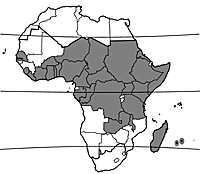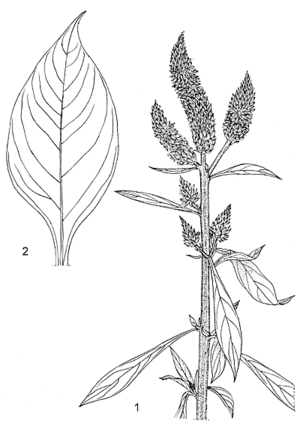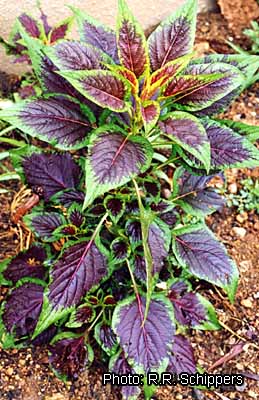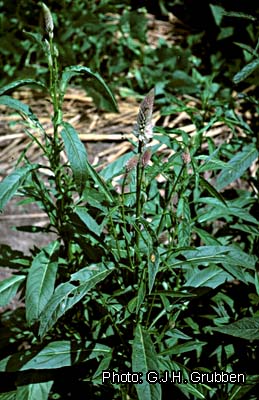Celosia argentea (PROTA)
Introduction |
| General importance | |
| Geographic coverage Africa | |
| Geographic coverage World | |
| Vegetable | |
| Carbohydrate / starch | |
| Medicinal | |
| Ornamental | |
| Forage / feed | |
| Food security | |
- Protologue: Sp. pl. 1: 205 (1753).
- Family: Amaranthaceae
- Chromosome number: 2n = 36, 72, 108
Vernacular names
- Celosia, Lagos spinach, soko, quail grass, cock’s comb (En).
- Célosie, célosie argentée, crête de coq (Fr).
- Amaranto branco (Po).
- Mfungu (Sw)
Origin and geographic distribution
The wide diversity of Celosia argentea in tropical Africa points to an origin in this region. Celosia argentea is a widespread weed throughout tropical Africa, from Senegal east to Somalia and south to northern South Africa and the Indian Ocean islands, and a traditional vegetable in West and Central Africa. It is one of the leading leaf vegetables in south-western Nigeria, where it is known as ‘soko yòkòtò’ in the Yoruba language, meaning ‘make husbands fat and happy’. It is extremely important as well in southern Benin, also popular in Togo, Ghana and Cameroon, and recorded as a vegetable from several other West and Central African countries. Outside Africa, it occurs in tropical and subtropical Asia and America. The ornamental forms of Celosia argentea with fasciated inflorescences (cock’s comb) probably originate from India. These are widely grown as an ornamental in the tropics and subtropics, and in summer in temperate regions.
Uses
Celosia is primarily used as a leafy vegetable. The leaves and tender stems are cooked into soups, sauces or stews with various ingredients including other vegetables such as onions, hot pepper and tomato, and with meat or fish and palm oil. Celosia leaves are tender and break down easily when cooked only briefly. The soup is consumed with the staple food of maize, rice, cassava or yam. The young inflorescences are also eaten as a potherb.
In Kenya, the Masai use the liquid extract from the leaves and flowers as a bodywash for convalescents. The whole plant is used as an antidote for snakebites and the roots to treat colic, gonorrhoea and eczema. In Ethiopia and DR Congo the seeds are used as medicine for diarrhoea, and in Ethiopia the flowers to treat dysentery and muscle troubles. In China, the leaves are used as medicine in the treatment of infected sores, wounds and skin eruptions, and in China and Japan seed extracts have traditionally been used as a therapeutic drug for eye and hepatic diseases. In India, the leaves mixed with honey are applied to inflated areas or abscesses, and the seeds are widely used for the treatment of diabetes mellitus. In South-East Asia, the flowers are used as medicine for dysentery, haemoptysis and menstruation problems. In DR Congo the plant is associated with occult and witchcraft beliefs. Celosia can also be used as a livestock feed. Forms with fasciated, yellow to red inflorescences are widely grown as a bedding plant in gardens and also used as cut flowers. These are also planted in Africa.
Production and international trade
Celosia is cultivated on small and scattered plots in home gardens, farmland and urban and peri-urban areas making it difficult to estimate the cultivated area, but it must amount to thousands of hectares. It is a vegetable of high economic value, particularly in the dry season, and commands market prices similar to those of amaranth (Amaranthus cruentus L.). In Benin and Nigeria, young celosia plants are sold in small bundles (0.5–1.0 kg) in main and small street markets. There is no registered international trade, but occasionally small quantities are exported from Nigeria to the United Kingdom and the United States for sales to the resident African communities.
Properties
The composition of Celosia argentea per 100 g edible portion is: water 83.8 g, energy 185 kJ (44 kcal), protein 4.7 g, fat 0.7 g, carbohydrate 7.3 g, fibre 1.8 g, Ca 260 mg, P 43 mg, Fe 7.8 mg (Leung, W.-T.W., Busson, F. & Jardin, C., 1968). It is a dark green leafy vegetable with a high content of micronutrients, comparable with amaranth (Amaranthus cruentus). Young leaves harvested 5–7 weeks after sowing have the best nutritional value and are especially rich in Fe, vitamin A and vitamin C. The leaves contain phytic acid (120 mg/100g) and oxalic acid (20 mg/100g). The high oxalic acid content makes the leaves less suitable for fresh consumption. The composition is strongly influenced by environmental factors, e.g. soil fertility, fertilizer application and age of plant at harvest.
In tests in India, Celosia argentea seeds reduced blood glucose in alloxan-induced diabetic rats. Aqueous seed extracts showed antimetastatic and immunomodulating properties in tests with mice. The acidic polysaccharide celosian isolated from the seeds was found to be a potent antihepatotoxic agent for chemical and immunological liver injury models in animals. The antimitotic bicyclic peptides celogentins A–C and moroidin have been isolated from the seeds, and an antiviral protein has been isolated from the leaves.
Celosia argentea contains red betacyanins and yellow betaxanthins which are being tested as food colorants. Several glycopyranosyls have been isolated from celosia, including citrusin C which has skin depigmentation properties. The seed of Celosia argentea contains a fatty oil known as ‘celosia oil’ in India.
Adulterations and substitutes
In dishes, leafy vegetables prepared in the same way, especially amaranths and other Celosia species, can be used as a substitute for Celosia argentea.
Description
- Erect annual herb up to 2 m tall; stem ridged, glabrous, branches up to 25 per plant, ascending.
- Leaves alternate, simple, without stipules; petiole indistinctly demarcated; blade ovate to lanceolate-oblong or narrowly linear, up to 15(–20) cm × 7(–9) cm, tapering at base, acute to obtuse and shortly mucronate at apex, entire, glabrous, pinnately veined.
- Inflorescence a dense, many-flowered spike, at first conical but becoming cylindrical, up to 20 cm long, bracteate, silvery to pink, in ornamental forms completely or partly sterile and in many colours.
- Flowers small, bisexual, regular, 5-merous; tepals free, narrowly elliptical-oblong, 6–10 mm long; stamens fused at base; ovary superior, 1-celled, style filiform, up to 7 mm long, stigmas 2–3, very short.
- Fruit an ovoid to globose capsule 3–4 mm long, circumscissile, few-seeded.
- Seeds lenticular, 1–1.5 mm long, black and shining, shallowly reticulate.
Other botanical information
Celosia comprises about 50 species and occurs in all tropical and subtropical regions. Celosia argentea is by far the most popular and most widely cultivated species. There are three major types of Celosia argentea cultivated as vegetable in Nigeria and Benin: green broad-leaved cultivars called ‘Soko green’; broad-leaved cultivars with anthocyanin pigmentation of the leaf blades and parts of the stem called ‘Soko pupa’; and cultivars with deep green narrow leaves with a hard texture and early flowering. ‘ Soko pupa’ imparts the anthocyanin-red colour into the soup, making it less popular than ‘Soko green’. Improved cultivars of ‘Soko green’ with broad pale green leaves are more vigorous.
Ornamental types of Celosia argentea with fasciated inflorescences have been described as Celosia cristata L. and were later considered as a variety or form of Celosia argentea. They are tetraploid (2n = 36), rarely 12x (2n = 108), whereas wild plants are usually octoploid (2n = 72) and rarely tetraploid (in India).
Growth and development
The seedling emerges 5–7 days after sowing. Early vegetative growth is slow but flowering may occur already 6–7 weeks after sowing. Improved cultivars have a more rapid early vegetative development but flower later, 12–14 weeks after sowing. The early flowering of local cultivars or wild types makes them less attractive to consumers and more amenable to once-over harvesting by uprooting, whereas the improved cultivars can be harvested by uprooting as well as by repeated cutting. Flowering is delayed by repeated cutting of the tender vegetative parts. Pollination is by wind and insects, especially bees and flies, which visit the flowers regularly. Seed maturity starts from the basal part of the inflorescence and gradually moves up to the tip. Consequently, seeds from the basal parts of the inflorescence are more vigorous than those from the middle and apical regions. Seeds are mature in 10–20 weeks from sowing and shatter when the inflorescence is dry. They remain dormant on the soil surface until the start of the next rainy season.
Ecology
Celosia grows well in the lowland humid forest zone at day temperatures of 30–35°C and night temperatures of 23–28°C and at an altitude up to 1700 m. Growth is greatly retarded by temperatures below 20°C, consequently it does not grow well in the savanna region of West Africa during the harmattan period. Celosia performs well under partial shade, especially in dry conditions. Photosynthesis in celosia follows the C3-cycle pathway; therefore about 60% of full sunlight is adequate for optimal growth, making celosia especially suitable for production in shady home gardens.
A well-drained sandy loam soil allows optimum growth, but celosia also grows well on marshy soils. In Nigeria and Benin it is frequently produced during the dry season in so-called ‘fadama’ cropping systems, i.e. on hydromorphic soils of river banks and seasonally flooded areas. An additional advantage is that the flooding eliminates the Meloidogyne root-knot nematode problem. Celosia tolerates moderately saline soils of 25–50 mM NaCl. It is moderately resistant to drought and performs well under low water supply of the dry season, but severe drought promotes early flowering. The rainfall requirement during the rainy season is 500–1000 mm.
Propagation and planting
Celosia is grown on raised beds, ridges or flat beds. It is propagated by seed, either direct sown or transplanted. The 1000-seed weight is 1.0–1.1 g. For direct sowing, used for harvesting by uprooting whole young plants, a seed rate of 6–9 g per 10 m2 is used for sowing in rows or broadcasting. Seed is sometimes mixed with dry fine sand to obtain an even seed distribution. Direct sowing is prone to excessive use of seed, excessively high plant densities, difficult management, poor vegetative growth and low yield. With transplanting, less seed is required. Seed is then first sown in nursery beds and after 2–3 weeks the seedlings are transplanted. For harvesting by pruning the seedlings are widely spaced (15 cm × 15 cm on the beds), for once-over harvest by uprooting a spacing of 10 cm × 10 cm is adequate. Compared to direct sowing, transplanting gives more uniform and vigorous plants. Crop management, e.g. weeding and fertilizer application, is also easier using transplanting; the yield is high and the plant quality is better. Celosia is often grown in intercropping systems with other vegetables, cassava or yam. For seed production, a number of plants are set aside after the first harvest. These plants are cut at a lower height to encourage the production of lateral shoots. The seed yield is 200–700 kg/ha.
Management
No weeding is required if the land is well prepared before sowing and harvesting is by uprooting. In case of wider planting for repeated harvesting with improved cultivars, 1–2 weedings are needed before the start of flowering. In mixed cropping celosia competes better with weeds than Jew’s mallow (Corchorus olitorius L.), but less so than amaranth. Irrigation is optional during the rainy season. During the dry season, depending on the severity of heat and evapotranspiration, 2 irrigations per week are recommended, applying a total of 45 mm water. Celosia tolerates dry soil better than amaranth. It responds well to nutrients; a basal fertilizer treatment is not necessary if it is grown on rich soils. For optimum vegetative growth on poor or moderately fertile soils, application of complete NPK fertilizer at a rate of 400 kg/ha in a single dose is needed if the crop is harvested by uprooting, and 600 kg/ha split into two equal applications if the crop is harvested by successive cuttings. Organic manure, e.g. poultry manure, cow dung or domestic refuse, at a rate of 25–40 t/ha is a suitable alternative for inorganic fertilizers. Organic manure will not only increase growth but also reduce the population and effects of root-knot nematodes.
Diseases and pests
Celosia is susceptible to several leaf fungi, which can be severe when air humidity is high and during rainy weather and result in poor leaf quality. Cercospora celosiae causes red-rimmed grey spots on the leaves. White rust (Albugo bliti) forms white pustules on the underside of the leaves. Other diseases affecting the leaf quality are Alternaria leaf spot (Alternaria spp.) and charcoal rot (Macrophomina phaseolina, Curvularia spp.), which cause dark spots on the leaves. Wet rot or stem rot caused by Choanephora cucurbitarum, the main disease of amaranth during the wet season, is sometimes serious in densely planted celosia. Rhizoctonia solani and Pythium aphanidermatum cause damping-off of seedlings. Celosia is highly susceptible to root-knot nematodes (Meloidogyne spp.) causing galls on roots, unthrifty growth, small and chocolate-coloured leaves as well as reductions in yield of up to 40%. It is therefore recommended that celosia not be grown continuously and that it not be followed by other crops susceptible to root-knot nematodes such as okra, gboma eggplant, Jew’s mallow, lettuce or tomato. Variation in degree of susceptibility to root-knot nematodes exists among cultivars, but no resistant cultivars have been reported. However, the application of much organic manure reduces the nematode population, as well as annual flooding. Caterpillars of Hymenia recurvalis and Psara bipunctalis feed on the leaves. The use of appropriate pesticides can control them. Spraying should start at detection of the caterpillars and should be applied once a week for three weeks. Grasshoppers and aphids cause minor damage in celosia.
Harvesting
Celosia is harvested either by uprooting or by repeated pruning of the stem which encourages production of side shoots for further cuttings. Growers at times combine the two methods, first uprooting as a thinning operation to encourage vigorous growth among the remaining plants, which are then harvested by repeated cutting. Depending on soil fertility and moisture, the crop is ready for uprooting 4–5 weeks after direct seeding or about 4 weeks after transplanting. The first cutting is carried out at a height of 10–15 cm leaving a sufficient number of axillary buds for the production of lateral shoots. Subsequent cuttings are carried out at 2-weekly intervals, allowing 4–5 harvests before the start of flowering. Flowering is delayed by regular cutting. Traditional cultivars flower earlier than improved ones and are therefore not suitable for harvesting by repeated cutting.
Yield
In an experiment in Nigeria a yield of a well-managed crop harvested by uprooting was 47 t/ha, while repeated cuttings yielded 57 t/ha. Repeated cuttings also resulted in a better quality of the produce and less inedible waste and gave a higher economic return. Although celosia is a productive leafy vegetable, its yields are lower than those of amaranth.
Handling after harvest
Harvested plants are bundled and tied after washing of soil from the roots. They are then sprinkled with water to keep them fresh for marketing. If harvested late in the evening, the plants are spread on a roof overnight and kept fresh by the night dew. In the market, the plants are tied into small-sized bundles of 0.5–1.0 kg for sale. They are kept covered by jute cloth and regularly watered. Shelf life of uprooted plants is extended by 2–3 days by keeping the roots in a basin with water.
Genetic resources
A collection of Celosia germplasm is maintained at NIHORT, Ibadan, Nigeria and several working collections are maintained elsewhere in West Africa. Celosia argentea is one of the 24 vegetable species identified by IBPGR in 1979 which show genetic erosion and are of local importance or rank second in priority on global scale. Germplasm collections are required for conservation, screening and selection of improved cultivars.
Breeding
Limited breeding work has been done on celosia. In Nigeria selections have been made in local and improved cultivars based on leaf size and shape, and on flowering period. Lines have been selected for low red or purple colouration in the leaves. Completely green cultivars were selected in Benin and Nigeria and are now generally used. Improved cultivars are more efficient in terms of leaf production and leaf area per plant than the unselected local cultivars.
Prospects
Celosia argentea is a nutritious and easy to cultivate vegetable, important for southern Nigeria and Benin and with potential for other lowland areas. Improved Nigerian cultivars are late maturing and suitable for repeated cuttings, and have a high yield under proper management. Suitable cultivars with rapid early vegetative growth should be selected for harvesting by uprooting. Breeding and selection work should aim at the development of cultivars with resistance to diseases and pests, particularly root-knot nematodes. Research should also focus on the development of adequate cultural practices in sole and intercropping systems, including irrigation. Simple and cheap storage systems that can be used to prolong the shelf life of harvested seedlings as well as ensure good leaf quality for marketing are also required.
Major references
- Babatola, J.O. & Ogunware, J.B., 1978. Effects of the root-knot nematode, Meloidogyne incognita on growth and yield of three local vegetables. In: Proceedings of the first annual conference of Horticultural Society of Nigeria (HORTSON), Ibadan, Nigeria, November 1–3, 1978. pp. 95–105.
- Badra, T., 1993. Lagos spinach. In: Williams, J.T. (Editor). Pulses and vegetables: underutilized crops. Chapman & Hall, London, United Kingdom. pp. 131–163.
- Burkill, H.M., 1985. The useful plants of West Tropical Africa. 2nd Edition. Volume 1, Families A–D. Royal Botanic Gardens, Kew, Richmond, United Kingdom. 960 pp.
- Grubben, G.J.H., 1975. La culture de l’amarante, légume-feuilles tropical, avec référence spéciale au Sud-Dahomey. Mededelingen Landbouwhogeschool Wageningen 75–6. Wageningen, Netherlands. 223 pp.
- Grubben, G.J.H., 1977. Tropical vegetables and their genetic resources. IBPGR, Rome, Italy. 197 pp.
- Martin, F.W. & Ruberté, R.M., 1975. Edible leaves of the tropics. Agency for International Development Department of State, and the Agricultural Research Service, U.S. Department of Agriculture, United States. 235 pp.
- Prem Nath & Denton, L., 1980. Leafy vegetables in Nigeria. Plant Genetic Resources Newsletter 42: 14–17.
- Schippers, R., 1997. Appendix 1. Selected indigenous cultivated vegetables from West and East Africa. In: Schippers, R. & Budd, L. (Editors). Proceedings of a workshop on African indigenous vegetables, Limbe, Cameroon, January 13–18, 1997. Natural Resources Institute, Chatham, United Kingdom. pp. 137–147.
- Schippers, R.R., 2000. African indigenous vegetables. An overview of the cultivated species. Natural Resources Institute/ACP-EU Technical Centre for Agricultural and Rural Cooperation, Chatham, United Kingdom. 214 pp.
- Townsend, C.C., 1985. Amaranthaceae. In: Polhill, R.M. (Editor). Flora of Tropical East Africa. A.A. Balkema, Rotterdam, Netherlands. 136 pp.
Other references
- Aletor, M.V.A. & Adeogun, O.A., 1995. Nutrient and anti-nutrient components of some tropical leafy vegetables. Food Chemistry 53: 375–397.
- Babatola, J.O., 1988. Influences of organic manures and urea on the nematode pests of Celosia argentea. NIHORT Research Bulletin No 3. National Horticultural Research Institute, Ibadan, Nigeria. 10 pp.
- Cai, Y., Sun, M., Schliemann, W. & Corke, H., 2001. Chemical stability and colorant properties of betaxanthin pigments from Celosia argentea. Journal of Agricultural and Food Chemistry 49: 4429–4435.
- Hase, K., Basnet, P., Kadota, S. & Namba, T., 1997. Immunostimulating activity of celosian, an antihepatotoxic polysaccharide isolated from Celosia argentea. Planta Medica 63(3): 216–219.
- Hayakawa, Y., Fujii, H., Hase, K., Ohnishi, Y., Sakukawa, R., Kadota, S., Namba, T. & Saiki, I., 1998. Anti-metastatic and immunomodulating properties of the water extract from Celosia argentea seeds. Biological and Pharmaceutical Bulletin 21(11): 1154–1159.
- Ikeorgu, J.E.G., 1990. Glasshouse performance of three leafy vegetables grown in mixture in Nigeria. Scientia Horticulturae 43: 181–188.
- Ifon, E.T. & Bassir, O., 1979. The nutritive value of some Nigerian leafy green vegetables. Part 1: Vitamin and mineral content. Food Chemistry 4(4): 263–267.
- Keshinro, O.O. & Ketiku, A.O., 1979. Effect of traditional cooking methods on the ascorbic acid content of some Nigerian leafy and fruit vegetables. Food Chemistry 4: 303–310.
- Khoshoo, T.N. & Pal, M., 1973. The probable origin and relationships of the garden cockscomb. Botanical Journal of the Linnean Society 66(2): 127–141.
- Kogbe, J.O.S., 1980. Effects of poultry manure on the yield components of Celosia argentea. Vegetables for the Hot Humid Tropics 5: 54–60.
- Leung, W.-T.W., Busson, F. & Jardin, C., 1968. Food composition table for use in Africa. FAO, Rome, Italy. 306 pp.
- NIHORT, 1983. Annual Report of the National Horticultural Research Institute. NIHORT, Ibadan, Nigeria. 101 pp.
- NIHORT, 1985. Annual Report of the National Horticultural Research Institute. NIHORT, Ibadan, Nigeria. 67 pp.
- Nwanguma, E.I., 1997. Preliminary studies on the effect of organic manure in the control of root knot nematode, Meloidogyne incognita and growth of okra and tomato in South-Western Nigeria. In: Adejoro, M.A. & Aiyelaagbe, I.O.O. (Editors). Proceedings of the 15th annual conference of the Horticultural Society of Nigeria (HORTSON). National Horticultural Research Institute, Ibadan, Nigeria. pp. 166–168.
- Okigbo, B.N., 1983. Fruits and vegetable production and extension services in Africa. Acta Horticulturae 123: 23–36.
- Prem Nath & Denton, L., 1979. Vegetable germplasm in Nigeria. Plant Genetic Resources Newsletter 39: 24–25.
- Sawabe, A., Nomura, M., Fujihara, Y., Tada, T., Hattori, F., Shiohara, S., Shiomomura, K., Matsubara, Y., Komemushi, S., Okamoto, T. & Kawamura, S., 2001. Cosmetic substances for skin depigmentation from African dietary leaves, Celosia argentea L. Bulletin of the Institute of Comprehensive Agricultural Science, Kinki University 9: 143–146.
- Schliemann, W., Cai, Y., Degenkolb, T., Schmidt, J. & Corke, H., 2001. Betalains of Celosia argentea. Phytochemistry 58: 159–165.
- van Epenhuijsen, C.W., 1974. Growing native vegetables in Nigeria. FAO, Rome, Italy. 113 pp.
- van Sloten, D.H., 1980. Vegetable genetic resources. Plant Genetic Resources Newsletter 44: 20–25.
Sources of illustration
- Grubben, G.J.H., 1975. La culture de l’amarante, légume-feuilles tropical, avec référence spéciale au Sud-Dahomey. Mededelingen Landbouwhogeschool Wageningen 75–6. Wageningen, Netherlands. 223 pp.
Author(s)
- O.A. Denton, National Horticultural Research Institute, P.M.B. 5432, Idi-Ishin, Ibadan, Nigeria
Correct citation of this article
Denton, O.A., 2004. Celosia argentea L. [Internet] Record from PROTA4U. Grubben, G.J.H. & Denton, O.A. (Editors). PROTA (Plant Resources of Tropical Africa / Ressources végétales de l’Afrique tropicale), Wageningen, Netherlands.
Accessed 6 March 2025.





